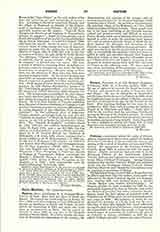

Pierron, JEAN, missionary, b. at Dun-sur-Meuse, France, September 28, 1631; date and place of death un-known. He entered the Jesuit novitiate at Nancy, November 21, 1650, and after studying at Pont-a-Mousson he became an instructor at Reims and Verdun; he completed the curriculum in 1665 and spent two years more as an instructor at Metz. On his arrival in Canada in June, 1667, he was sent to the Iroquois mission of Sainte-Marie. In a letter written the same year he described his impressions of the country, the characteristics and customs of the savages, and expressed an admiration for the Iroquois language, which reminded him of Greek. He arrived at Tionontoguen, the principal village of the Mohawks, on October 7, 1668, where he replaced Father Fremin. These people were one of the most flourishing of the Iroquois nations, valiant and proud warriors, and difficult to convert. Father Pierron made use of pictures which he painted himself in order to make his teachings more impressive, and invented a game by means of which the Indians learned the doctrines and devotions of the Church; he taught the children to read and write. He spent one winter in Acadia to ascertain if it were possible to reestablish the missions which had been expelled in 1655, and traveled through New England, Maryland (which at that time had a Catholic governor, Charles Calvert), and Virginia; returning to the Iroquois, he worked among them until 1677 and went to France in the following year. He was a man of rare virtue, and during all his missionary career fought against a natural repugnance to the Iroquois.
J. ZEVELY

